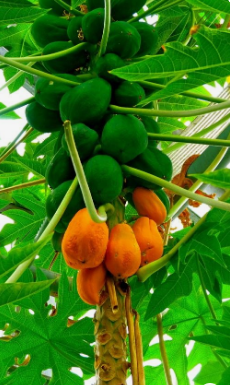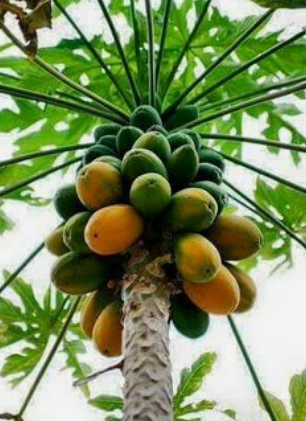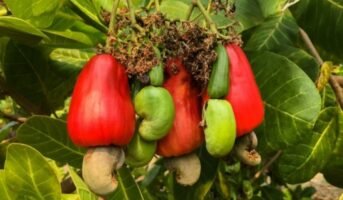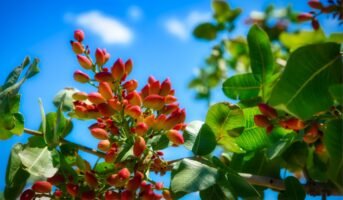The Carica papaya plant, also known as papaw or pawpaw, is a large tree in the Caricaceae family that bears sweet fruit. The papaya may be a hybrid of two or more Carica species native to Mexico and Central America, even though its origins are somewhat uncertain. Today, it is grown in all tropical regions and the warmest regions of the subtropics. A nice musky flavour that is slightly sweet and stronger in some varieties and climates than others can be found in papaya fruit.

Source: Pinterest
Papaya tree facts
Despite growing up to 8 meters (26 feet) tall and having a palm-like trunk, the papaya plant is very woody. Although the species is typically dioecious, with male and female flowers growing on different plants, known as hermaphrodite varieties, many anomalies exist in the distribution of the sexes. On stalks 90 cm long, male flowers are produced in clusters. These funnel-shaped, whitish flowers are 2.5 mm (0.1 inches) in length and have 10 stamens in the throat. The female flowers are much larger, grow on short stalks, and are frequently found alone in the leaf axils.

Source: Pinterest
The fruit often has a spherical or cylindrical shape, measures 75 to 500 mm (3 to 20 inches) in length or even longer, and occasionally weighs up to 9 to 11.5 kg (20 to 25.5 pounds). The delicious flesh has a rich yellow, orange, or crimson hue. The numerous spherical, wrinkled black seeds adhere to the walls of the expansive central chamber.
How to grow a Papaya tree?
Typically, papayas are cultivated from seeds. Papaya trees are often grown from the seed removed from ripe fruit. Fruit purchased at a food store is almost certainly from a bisexual plant. For maximum germination, put many seeds per pot. Their growth is quick, and fruit starts to appear before the first year is over. In around 2 weeks, seedlings may appear in direct sunshine. Plants should be placed 8 to 10 feet (2.5-3 m) apart after being 1 foot (0.5 m) tall. After 5 to 6 months, the seedlings will bloom.
Papaya plant care in the home landscape
Papaya trees need fertiliser to grow and be successful. Every 14 days, fertilise young plants with 14 pounds (113.5 g) of complete fertiliser. Older trees should be fertilised once a month with 1 to 2 pounds of fertiliser. Take a soil sample, and add nutrients.

Source: Pinterest
For best fruit production, give plants regular watering. Keep the mulch 8 to 12 inches away from the trunk. Wood chips of mulch trees are 4 inches (10 cm). Cover developing fruit with a paper bag to keep pests away.
Diseases caused by papaya tree
The plant virus Papaya ringspot virus-type P (PRSV-P), which is a member of the genus Potyvirus and family Potyviridae, is the culprit behind papaya ringspot disease.
There are 2 different varieties of papaya ringspot virus:
- The PRSV-P (Papaya Ringspot Virus) infects papaya and other cucurbits.
- PRSV-W, a virus that only affects cucurbit plants, including cucumber, melon, pumpkin, squash, and zucchini, causes ringspot on papayas.
Tips for growing papayas
Growing papaya trees depend on several factors, such as ecology, temperature, soil, climate, sunlight, etc. Let’s discuss all the aspects one by one in brief.
Ecology
Papaya may be grown successfully in various environments, including the equatorial tropics and temperate latitudes. However, it must be developed in warm, wind-protected, sunny locations, ideally lower than 1500 meters. Prosper in tropical and subtropical environments. If the temperature falls below 32 degrees, the trees might get damaged since they cannot withstand freezing temperatures.
Distribution and habitat
Hawaii, India, Australia, and central Africa are the current locations of almost pan-tropical papaya farming. Papaya wild populations are mostly restricted to tropical forests that have been naturally distributed. The papaya is a quick-growing, short-lived woody plant. They typically have a single trunk and can reach heights of 10 to 15 feet, while certain species have been reported to reach greater heights.
Sunlight
Plants thrive in full sunlight. The sun and heat are great for papayas.
Fertiliser
Papayas are big feeders and need fertiliser frequently. Composting is good for growth.
Water
Papayas require more watering than usual because of their large, soft leaves, which evaporate water in warm weather.
Soil
Rich, organically-rich soil is ideal for papaya growth. To prevent root rot, ensure the soil and planting area has excellent drainage.
Harvesting
Fruit is plucked when a colour change is seen. Keep at room temperature to finish ripening after picking. Ripe fruit should be kept in the refrigerator for 4 to 7 days.
FAQs
Do two papaya trees are required to bear fruit?
As the male blooms on the tree can pollinate the female flowers on the same tree, papaya does not require the pollination of a second tree. However, papaya plants will produce more fruit when another tree is nearby.
Where does papaya grow best?
The south or southeast side of a building, with some protection from wind and cold weather, is an excellent location to grow papayas. Additionally, papayas thrive in full sun. Because papaya trees have shallow roots and prefer well-drained soil, they cannot withstand damp conditions when growing.
Can papayas be grown in pots?
Given that papaya is a little tree with shallow roots and a short lifespan, growing papaya in containers is not difficult. To make it shorter, any papaya variety can be grown in a pot with the top removed. However, if you have a choice, it is preferable to pick a dwarf variety.
How often do papaya trees produce fruit?
A papaya tree typically produces 2 to 4 ripe fruits every week when it is fruiting on papaya plantations, typically located in tropical areas. A robust papaya tree can yield up to 75 pounds of fruit per year.
Housing News Desk is the news desk of leading online real estate portal, Housing.com. Housing News Desk focuses on a variety of topics such as real estate laws, taxes, current news, property trends, home loans, rentals, décor, green homes, home improvement, etc. The main objective of the news desk, is to cover the real estate sector from the perspective of providing information that is useful to the end-user.
Facebook: https://www.facebook.com/housing.com/
Twitter: https://twitter.com/Housing
Email: editor@housing.com











